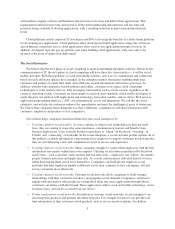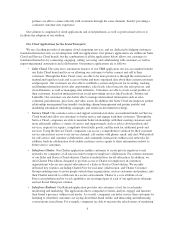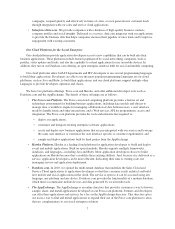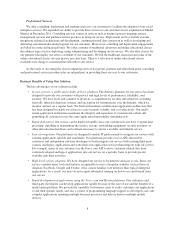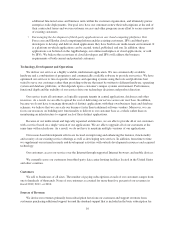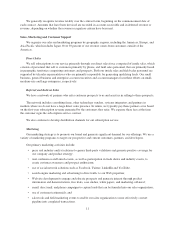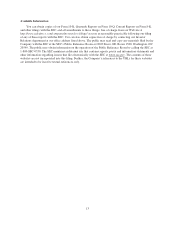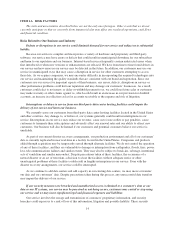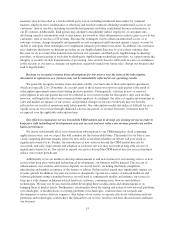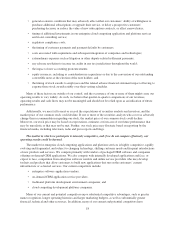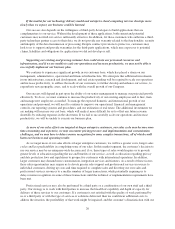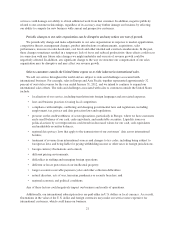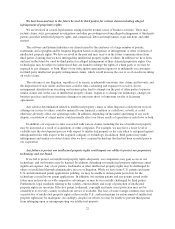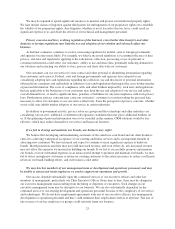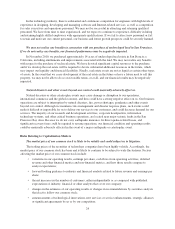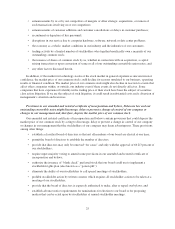Salesforce.com 2012 Annual Report Download - page 19
Download and view the complete annual report
Please find page 19 of the 2012 Salesforce.com annual report below. You can navigate through the pages in the report by either clicking on the pages listed below, or by using the keyword search tool below to find specific information within the annual report.measures may be breached as a result of third-party action, including intentional misconduct by computer
hackers, employee error, malfeasance or otherwise and result in someone obtaining unauthorized access to our
customers’ data or our data, including our intellectual property and other confidential business information, or
our IT systems. Additionally, third parties may attempt to fraudulently induce employees or customers into
disclosing sensitive information such as user names, passwords or other information in order to gain access to our
customers’ data or our data or IT systems. Because the techniques used to obtain unauthorized access, or to
sabotage systems, change frequently and generally are not recognized until launched against a target, we may be
unable to anticipate these techniques or to implement adequate preventative measures. In addition, our customers
may authorize third-party technology providers on our AppExchange directory to access their customer data.
Because we do not control the transmissions between our customers and third-party AppExchange technology
providers, or the processing of such data by third-party AppExchange technology providers, we cannot ensure the
integrity or security of such transmissions or processing. Any security breach could result in a loss of confidence
in the security of our service, damage our reputation, negatively impact our future sales, disrupt our business and
lead to legal liability.
Because we recognize revenue from subscriptions for our service over the term of the subscription,
downturns or upturns in new business may not be immediately reflected in our operating results.
We generally recognize revenue from customers ratably over the terms of their subscription agreements,
which are typically 12 to 24 months. As a result, most of the revenue we report in each quarter is the result of
subscription agreements entered into during previous quarters. Consequently, a decline in new or renewed
subscriptions in any one quarter may not be reflected in our revenue results for that quarter. Any such decline,
however, will negatively affect our revenue in future quarters. Accordingly, the effect of significant downturns in
sales and market acceptance of our service, and potential changes in our rate of renewals may not be fully
reflected in our results of operations until future periods. Our subscription model also makes it difficult for us to
rapidly increase our revenue through additional sales in any period, as revenue from new customers must be
recognized over the applicable subscription term.
Our efforts to expand our service beyond the CRM market and to develop our existing service in order to
keep pace with technological developments may not succeed and may reduce our revenue growth rate and/or
harm our business.
We derive substantially all of our revenue from subscriptions to our CRM enterprise cloud computing
application service, and we expect this will continue for the foreseeable future. The market for our Force.com
cloud computing platform remains relatively new and it is uncertain whether our efforts will ever result in
significant revenue for us. Further, the introduction of new services beyond the CRM market may not be
successful, and early stage interest and adoption of such new services may not result in long term success or
significant revenue for us. Our efforts to expand our service beyond the CRM market may not succeed and may
reduce our revenue growth rate.
Additionally, if we are unable to develop enhancements to and new features for our existing service or new
services that keep pace with rapid technological developments, our business will be harmed. The success of
enhancements, new features and services depends on several factors, including the timely completion,
introduction and market acceptance of the feature or edition. Failure in this regard may significantly impair our
revenue growth. In addition, because our service is designed to operate on a variety of network hardware and
software platforms using a standard browser, we will need to continuously modify and enhance our service to
keep pace with changes in Internet-related hardware, software, communication, browser and database
technologies. We may not be successful in either developing these modifications and enhancements or in
bringing them to market timely. Furthermore, uncertainties about the timing and nature of new network platforms
or technologies, or modifications to existing platforms or technologies, could increase our research and
development or service delivery expenses. Any failure of our service to operate effectively with future network
platforms and technologies could reduce the demand for our service, result in customer dissatisfaction and harm
our business.
15


